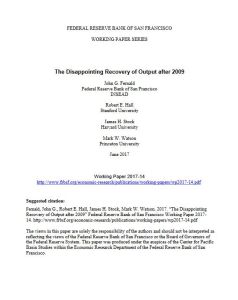Join getAbstract to access the summary!

Join getAbstract to access the summary!
John G. Fernald, Robert E. Hall, James H. Stock and Mark W. Watson
The Disappointing Recovery of Output after 2009
FRBSF, 2017
What's inside?
US GDP growth following the Great Recession has fallen far short of expectations.
Recommendation
Even before the Great Recession, the US economy was pushing against substantial headwinds that continue to blow. Research from economists John G. Fernald, Robert E. Hall, James H. Stock and Mark W. Watson points to a structural downshift in total factor productivity and a drop in labor force participation as major contributors to the tepid output growth since the bottom of the recession in 2009. GetAbstract recommends this authoritative report to policy experts, economists and analysts seeking to better understand the dynamics behind the US post-crisis economy.
Summary
About the Authors
John G. Fernald is a senior research adviser at the Federal Reserve Bank of San Francisco. Robert E. Hall, James H. Stock and Mark W. Watson are professors at Stanford, Harvard and Princeton Universities, respectively.


















Comment on this summary